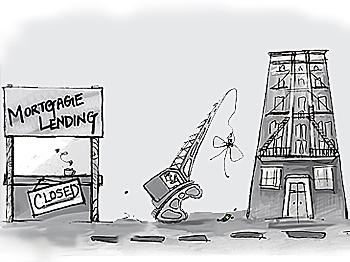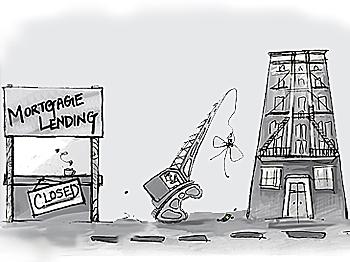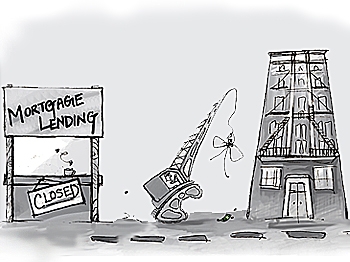“In each of the next four years there is over $300 billion of real estate debt that’s going to come due,” said Steven Herman, partner at law firm Cadwalader, Wickersham & Taft LLP.
Herman gleaned his statistics from talks he had with experts at Harvard University last month. “By 2013 they were talking about $1.4 trillion of real estate debt that’s going to mature.”
Snapshot of New Reality
“People are not willing to accept what is going on with the lack of demand,” Trop said of today’s market. “I do think there is a resistance to accept the new reality—the lack of liquidity and the new valuations.”
Steven Herman, partner at Cadwalader, said one of the differences between the 1990s and now is the severity of the downturn. “And you had also the advent of the CMBS market,” he said.
Many loans are going to default before they get to maturity, said Matthew Baron, Principal of Simon Development Group.
“Those are the sort of loans that are a lot more pressing for these institutions to handle, because they’re buildings that are not completed; they’re buildings that are just so over-leveraged that they’re not able to pay debt servicing,” he said, adding that those cracks are beginning to show up in the market now.
Tenants Under Scrutiny
Trop said the leasing environment has changed and people are looking at tenants more than what they have been in the past.
“Is a building that’s occupied by the New York Times lease at the same rate as a building which is occupied by Google worth the same thing?” he said. “And I think people are recognizing in their due diligence now, that it is not.”
In the past, Trop said, if you bought a building and a tenant bombed out on you, there were other tenants in the marketplace.
Lenders Working With Borrowers
“Because they know that they’ve got that borrower, that owner, that’s probably the best person to manage that asset,” said Baron. “Banks don’t want to own these assets.”
James McCarthy, chief investment officer, Strategic Capital Solutions, LLC, agreed.
“Banks have no incentive to take hits because it’s a loss to their earnings and the regulators are definitely letting them get away with whatever they can get away with,” he said.
“I met yesterday with a potential borrower who explained he has six loans that he has not paid for five months. And the bank only periodically calls up to make sure he’s maintaining the properties. There’s no action to take foreclosure. Banks are definitely not taking action if they can avoid it.”
However, Baron said the loans with buildings still under construction or empty, where there’s no cashflow and no tenants, are the one’s hitting the market now.
“They’re subject to the elements, they’re subject to potentially to squatters, to damage, or to the asset value outside of deterioration of the market,” he said.
Securitization Market Shut
“What we’re seeing, and we’re getting calls from different institutions, trying to figure out where the plays are and where the action is going to be,” he said.
“We’re seeing a lot of groups looking at the public markets to raise money, as a vehicle to essentially be a take-out from the CMBS, where it’s a more hybrid approach.”
He said no single lender is willing to take on a $100 million construction loan. “And because the securitization market is shut, the diversification of that risk is limited.”
He said new money is needed to come in and take the loan—alternative investment companies such as pension funds.
“Someone’s going to have to come in with real equity (20, 30, 40 percent) and that’s a challenge.”
Baron said financing depended on the type of property. “We’re finding in the multi-family world in New York City, our bread and butter is the $20 to $100 million deal size,” he said.
“We’re finding that between $10 and $50 million, you still have the local savings banks that have always been around and are willing to lend on existing cashflow and multi-family deals.
“That being said, they’re underwriting them to lower valuations so from the existing standpoint, the leverage is still there, but from a refinance standpoint, you’re getting hit.”
Bringing Capital Back to Market
Trop said good news means good news from Wall Street, job creation, and on the consumer front.
“Any good news is going to detract from the gigantic amount of fear which is leading to ... ‘how do I underwrite this? How do I discount this? How do I come up with a value for this when I don’t know how to lease it or sell it, or create something that somebody’s going to want to pay for.’”
Baron said a lot of firms (mainly real estate private equity firms) his company is speaking to have a “ton” of cash, but they don’t want to “be the first guy in.”
He said a recent negotiation fell through because of the fear and uncertainty of the environment, and suggested a critical mass needs to be reached in transaction volume before confidence picks up.
Herman said motivated sellers were the first necessary step to get the market moving. “There is a tremendous amount of capital sitting on the sidelines waiting to invest.”
When the market comes back, McCarthy said it may come back very fast. “As everyone suddenly says, ‘Well if I don’t jump in now, I will miss the opportunities.’”
















Friends Read Free